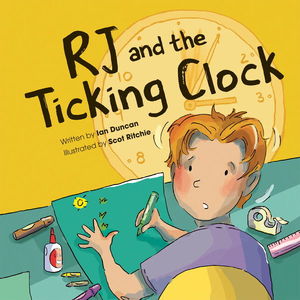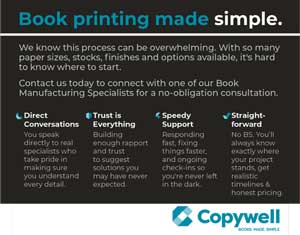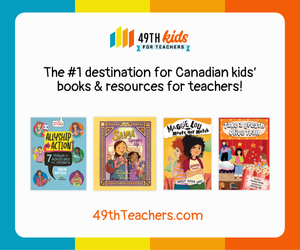RJ Races Against the Ticking Clock to Make the Perfect Father's Day Cards in Ian Duncan's New Picture Book
RJ is on a mission: he’s got just 30 minutes to make Father’s Day cards for his two amazing dads. As the seconds tick by, RJ’s determination turns into panic. With glue, glitter, and construction paper flying, will he ever manage to make both cards in time?
Written by Ian Duncan and brought to life with Scot Ritchie’s lively illustrations, RJ and the Ticking Clock is a heartwarming, high-energy story about one boy, two dads, and a race to deliver their gifts before time runs out.
This delightful and emotionally rich picture book perfectly captures the pressure kids can feel when trying to get everything just right. It’s a celebration of family, creativity, and the magic that happens when classmates and teachers come together in support.
Check out our Kid's Club BFYP interview with the author, right here on Open Book!
Open Book:
Tell us about your new book and how it came to be.
Ian Duncan:
RJ and the Ticking Clock is a story about a boy named RJ who loves math, even when the numbers don’t quite add up. He’s got 30 minutes to complete his Father’s Day cards for his two dads, and the math shows that 30 minutes is just not enough time! RJ gets one card done, and his teacher and classmates surprise him with the second card they pitched in to create for RJ.
My husband and I adopted our son privately in Ontario over 12 years ago. This book is inspired by our two-dad family and the Queer families we’ve come to know and love in our community. Our son was always determined to make two Father’s Day cards or crafts at school when he was younger - one for each of his dads. Every year, there were two paper neckties with sparkle glue shapes, or two paperweights, two popsicle stick framed pictures, or two cards coming home from daycare, preschool, or his primary grade classrooms.

OB:
Is there a message you hope kids might take away from reading your book?
ID:
Sometimes, when we’re most anxious, we need to lean on each other for help. There’s something really beautiful about the kind of allyship shown by RJ’s teacher (Mr. G) and his classmates in the story. They really see RJ for who he and his family are, helping him to find the time, get the numbers to add up, cheering him on when the math works out, and celebrating his family with two dads on Father’s Day.
Your CanLit News
Subscribe to Open Book’s newsletter to get local book events, literary content, writing tips, and more in your inbox
OB:
Did the book look the same in the end as your originally envisioned it when you started working, or did it change through the writing process? Is there a character in your book that you relate to? If so, in what ways are you similar to your character and in what ways are you different?
ID:
I’m innately anxious, so I clearly relate to RJ’s emotions in the story. We want things to be just right. He and I plan and re-plan, always doing the math, and still get stuck from time to time. We are both surprised (but also grateful) when others come to help. RJ is creative, loved and loving, and clearly very proud of his gay dads. He and I both try to get things done on our own, but we also come to know the importance of rallying friends for support.
OB:
What was the strangest or most memorable moment or experience during the writing process for you?
ID:
The most memorable moment for me was seeing the first outline sketches of the illustrations by Scot Ritchie. I feel like I’m a very visual writer; I see the story in so much detail in my head as I write it. I probably get too attached to those images, and it’s a really great exercise to turn the manuscript over to the interpretation of an illustrator. It was an honour to see Scot’s take on the text in the manuscript. He brought so much to our book, well beyond my imagination. There were also many happy similarities between what I envisioned in my head, and what he created in the illustrations. It proved that our partnership on this book was meant to be.
OB:
How do you cope with setbacks or tough points during the writing process? Do you have any strategies that are your go-to responses to difficult points in the process?
ID:
The toughest part of my writing process is knowing when a manuscript is done and ready to be shared with editors. I have created checklists of things I’ve learned to consider and reconsider, revise, edit, research, and reimagine. The checklists help, but it always seems a leap to submit a manuscript to a publisher. I think that’s even harder for me than hearing a polite “No Thank You” from an editor. The anxiety of ensuring that it’s your best work possible is somehow worse than the rejection; I always wonder if I could’ve done more or done better to hook an editor and my next contract.
OB:
What defines a great book for young readers, in your opinion? Tell us about one or two books you consider to be truly great kids books, whether you read them as a child or an adult.
ID:
For me, a character with a quirk (or two), a well turned phrase that is delightful to read (with perhaps a sprinkle of rhyme), and illustrations that are beautiful and also surprising, have always defined truly great children’s literature. I love the words, and I love the images that go with them. I think of the work of Andrea Beaty and David Roberts (Happy Birthday Madame Chapeau), Dylan Glynn (Rain Boy), and the collected works of Robert Munsch.
OB:
What's your favourite part of the life cycle of a book? The inspiration, writing the first draft, revision, the editorial relationship, promotion and discussing the book, or something else altogether? What's the toughest part?
ID:
My favourite part of a book’s life cycle is writing the first draft. I get to play, and if all of my (prior) over-thinking has served me well, I can get into a flow and get the initial book out.
The toughest part has to be working the manuscript from there. I find it harder to refine, focus, and simplify the story, especially on my own. I need great editors to help, but then I gather editors want to see books that are well-written from the outset.
OB:
What are you working on now?
ID:
I am excited to launch my first picture book, RJ and the Ticking Clock, illustrated by Scot Ritchie, published by Owlkids Books this year. I’m eagerly creating materials, activities, and resources to market the book, and amplify our book!
I am also writing as much as I possibly can. It’s not a small feat to find the time to write day-to-day, but I’m doing my best. I even find myself thinking through ideas, narratives, and characters when I’m commuting to work each day. I collect ideas, arcs, narratives, and situations and am always making notes on my phone. I have a few manuscripts I’ve submitted to various publishers in Canada, and continue to work on new stories with the hope that my next published book is just an email away.
I know I have stories to share and I’m so excited to have started my journey in children’s publishing.
_________________________________
Ian Duncan is a high school history teacher, husband, father, and writer. He has written and published history textbooks, and this is his first picture book. He lives in Toronto, Ontario, lives by the energy and anxiety of a ticking clock, and loves the art of a good story.
Scot Ritchie is an award-winning illustrator and author. His books have been translated into many languages, including French, Korean, Chinese, Finnish, Arabic and Dutch. He has worked with the National Film Board of Canada and had his illustrations exhibited at the National Gallery of Canada. As a freelancer Scot has been able to pack up his office and work in cities like Athens, Berlin, and Honolulu. He stays for a few months, convincing himself (he's quite impressionable) that he lives there. He actually lives in Vancouver, British Columbia.





